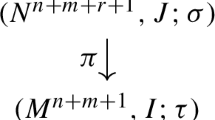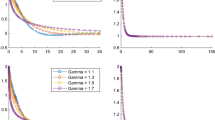Abstract
We prove that the parameter estimation error of continuous-time linear stochastic systems that is obtained in connection with a fixed-gain estimation method can be written as a stochastic integral plus a residual term, the moments of which are of orderλ+o(1) whereλ is the forgetting factor.
Similar content being viewed by others
References
Arató, M.:Linear Stochastic Systems with Constant Coefficients, Lecture Notes in Control and Information Science, Springer-Verlag, New York, 1984.
Åström, K. J. and Söderström, T.: Uniqueness of the maximum-likelihood estimates of the parameters of an ARMA 1974 model,IEEE Trans. Automat. Control AC-19 (1974), 769–773.
Bagchi, A. and Borkar, V.: Parameter identification of infinite dimensional linear systems,Stochastics 12 (1984), 201–213.
Gerencsér, L.: On a class of mixing processes,Stochastics 26 (1989), 165–191.
Gerencsér, L.: On the martingale approximation of the estimation error of ARMA parameters,Systems Control Lett. 15 (1990), 417–423.
Gerencsér, L., Gyöngy, I. and Michaletzky, Gy.: Continuous-time recursive maximum likelihood method. A new approach to Ljung's scheme, in L. Ljung and K. J. Aström (eds),A Bridge Between Control Science and Technology, Proc. of the 9th Triennal World Congress of IFAC, Identification, Adaptive and Stochastic Control, Pergamon Press, Oxford, 1984, pp. 75–77.
Gerencsér, L. and Vágó, Zs.: From fine assymptotics to model selection, in N. K. Sinha and G. P. Rao (eds),Identification of Continuous Time Systems, Kluwer Academic Publishers, Dordrecht, 1991, pp. 575–587.
Hunter, I. W., Lafontaine, S., Doukouglou, T. D., Jones, L. A., Korenberg, M. J., Nielsen, P. M., Kirsch, R. F. and Kearney, R. E.: Microrobotics and the study of muscle: Special problems in control, system identification and modelling, in Cs. Bányász and L. Keviczky (eds),Proc. 9th IFAC/IFORS Symposium on Identification and System Parameter Estimation, vol. 1, Pergatnon Press, Oxford, 1991, pp. 109–114.
Krylov, N. V.:Controlled Diffusion Processes, Nauka, Moscow, 1977 (in Russian) and Springer-Verlag, Berlin, 1980.
Kutoyants, Yu. A.:Estimation of Stochastic Processes, Publishing House of the Armenian Academy of Sciences, Yerevan, 1980 (in Russian) and Heldermann, Berlin, 1984.
Prakasa Rao, B. L. S.:Asymptotic Theory of Statistical Inference, Wiley, New York, 1987.
Vágó, Zs. and Gerencsér, L.: Uniqueness of the maximum-likelihood estimates of the Kalmangain matrix, in M. Ziermann (ed),Proc. IFAC Conference on Dynamic Modelling and Control of National Economics, Budapest, 1986, pp. 483–485.
Author information
Authors and Affiliations
Rights and permissions
About this article
Cite this article
Gerencsér, L., Vágó, Z. Fixed-gain estimation in continuous time. Acta Appl Math 35, 153–164 (1994). https://doi.org/10.1007/BF00994915
Received:
Issue Date:
DOI: https://doi.org/10.1007/BF00994915




